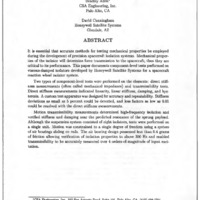-
Title
-
Testing Of A Viscous-Damped Isolator
-
Report Number
-
WL-TR-91-3078 Volume III, p. IAD-1 thru IAD-9
-
Creator
-
Allen, Bradley
-
Cunningham, David
-
Corporate Author
-
CSA Engineering, Inc.
-
Honeywell Satellite Systems
-
Date
-
1991
-
Date Issued
-
1991-08
-
Extent
-
9
-
Identifier
-
ADA241313
-
Format
-
1 online resource
-
Abstract
-
It is essential that accurate methods for testing mechanical properties be employed during the development of precision spacecraft isolation systems. Mechanical properties of the isolator will determine force transmission to the spacecraft; thus they are critical to its performance. This paper documents component-level tests performed on viscous-damped isolators developed by Honeywell Satellite Systems for a spacecraft reaction wheel isolator system. Two types of component-level tests were performed on the elements: direct stiffness measurements (often called mechanical impedance) and transmissibility tests. Direct stiffness measurements indicated linearity, linear stiffness, damping, and hysteresis. A custom test apparatus was designed for accuracy and repeatability. Stiffness deviations as small as 5 percent could be detected, and loss factors as low as 0.01 could be resolved with the direct stiffness measurements. Motion transmissibility measurements determined high-frequency isolation and verified stiffness and damping near the predicted resonance of the sprung payload. Although the suspension system consisted of eight isolators, tests were performed on a single unit. Motion was constrained to a single degree of freedom using a system of air bearings sliding on rails. The air bearing design possessed less than 0.4 grams of friction allowing verification of isolation properties to above 300 Hz and enabled transmissibility to be accurately measured over 4 orders-of-magnitude of input excitation.
-
Description
-
It is essential that accurate methods for testing mechanical properties be employed during the development of precision spacecraft isolation systems. Mechanical properties of the isolator will determine force transmission to the spacecraft; thus they are critical to its performance. This paper documents component-level tests performed on viscous-damped isolators developed by Honeywell Satellite Systems for a spacecraft reaction wheel isolator system. Two types of component-level tests were performed on the elements: direct stiffness measurements (often called mechanical impedance) and transmissibility tests. Direct stiffness measurements indicated linearity, linear stiffness, damping, and hysteresis. A custom test apparatus was designed for accuracy and repeatability. Stiffness deviations as small as 5 percent could be detected, and loss factors as low as 0.01 could be resolved with the direct stiffness measurements. Motion transmissibility measurements determined high-frequency isolation and verified stiffness and damping near the predicted resonance of the sprung payload. Although the suspension system consisted of eight isolators, tests were performed on a single unit. Motion was constrained to a single degree of freedom using a system of air bearings sliding on rails. The air bearing design possessed less than 0.4 grams of friction allowing verification of isolation properties to above 300 Hz and enabled transmissibility to be accurately measured over 4 orders-of-magnitude of input excitation.
-
Distribution Classification
-
1
-
Distribution Conflict
-
No
-
DTIC Record Exists
-
No
-
Illinois Tech Related
-
No
-
Photo Quality
-
Complete
-
Report Availability
-
Full text available
-
Type
-
article
 articleIAD
articleIAD